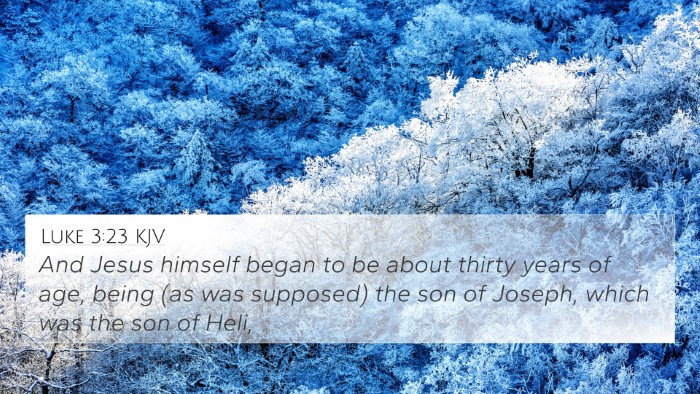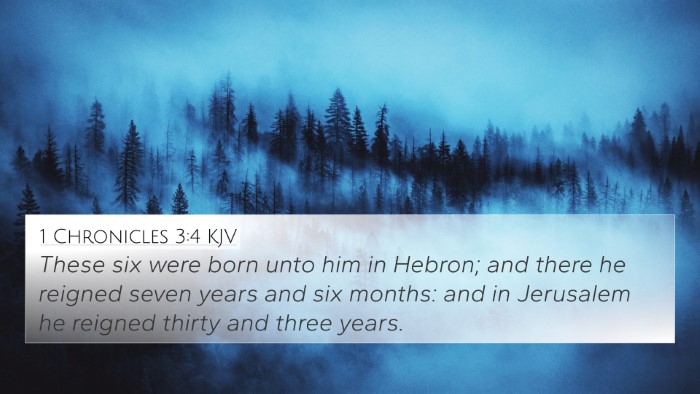Understanding 2 Samuel 5:4
2 Samuel 5:4 reads:
"David was thirty years old when he began to reign, and he reigned forty years."
This verse marks a significant moment in the biblical narrative, giving insight into David's reign as king over Israel. Below is a synthesis of interpretations from notable public domain commentaries.
Commentary Insights
Historical Context
Matthew Henry notes that this verse serves to establish David’s legitimacy and authority as king. At thirty years old, David stands at a pivotal age, having spent years preparing for leadership, both through his anointing by Samuel and through his experiences in Saul's court and in the wilderness.
Significance of Age
Adam Clarke emphasizes that thirty was typically considered the age of maturity and readiness for leadership in Israelite culture, which complements David’s ascent to the throne. His reign of forty years also highlights his enduring influence and the stability he brought to the nation.
Theological Implications
Albert Barnes suggests that David’s lengthy reign symbolizes God’s faithfulness to His promises. David’s position as king foreshadows the ultimate reign of Christ, establishing a typological connection that is crucial for understanding messianic expectations in scripture.
Bible Cross-References
To enrich your understanding of 2 Samuel 5:4, consider these related Bible verses:
- 1 Samuel 16:12-13: David’s anointing by Samuel marks the beginning of his journey to kingship.
- 2 Samuel 2:4: This verse highlights David being made king over the tribe of Judah, indicating the initial phase of his reign.
- 1 Chronicles 12:36: This scripture depicts the loyalty of the men of Issachar and their understanding of the times, reflecting David's supportive following.
- Psalm 78:71-72: This passage notes God choosing David to shepherd His people, symbolizing divine appointment.
- Matthew 1:6: This genealogy of Jesus emphasizes David’s royal lineage, relating back to our understanding of his kingship.
- Luke 1:32-33: The angel's announcement to Mary reiterates Jesus’ royal lineage as a fulfillment of promises made to David.
- Revelation 22:16: Jesus, referred to as the "Root and Offspring of David," ties back to the significance of David's kingship.
Connections and Themes
This verse is part of a greater narrative that speaks to themes of leadership, divine appointment, and the realization of God’s promises. Understanding David’s reign, beginning at the age of thirty and culminating in a forty-year reign, allows us to see God's hand in history and how it connects to both Old and New Testament teachings.
Thematic Bible Verse Connections
When linking Bible scriptures, we find that David’s reign is not isolated but forms a continuing dialogue across the scriptures:
- Leadership and preparation in God’s service (Exodus 3:10, Isaiah 6:8).
- God’s covenant and promises manifest in history (Genesis 12:1-3, 2 Samuel 7:16).
- The role of suffering and preparation for leadership (Philippians 1:29, Hebrews 5:8).
Applications for Study
For those engaged in a cross-reference Bible study, consider the following:
- How to find cross-references in the Bible: Utilize a Bible concordance or cross-reference guide for deeper engagement.
- Bible chain references: Follow thematic threads through different parts of scripture.
- Inter-Biblical dialogue: Examine how the New Testament authors reference Old Testament themes, especially regarding leadership and fulfillment of prophetic words.
Conclusion
2 Samuel 5:4 serves as a potent reminder of God's sovereignty in establishing leaders and fulfilling His promises. By engaging in comparative Bible verse analysis, we not only enrich our understanding of David but also see the foreshadowing of Christ's kingship and the unfolding of God's grand narrative throughout scripture.







